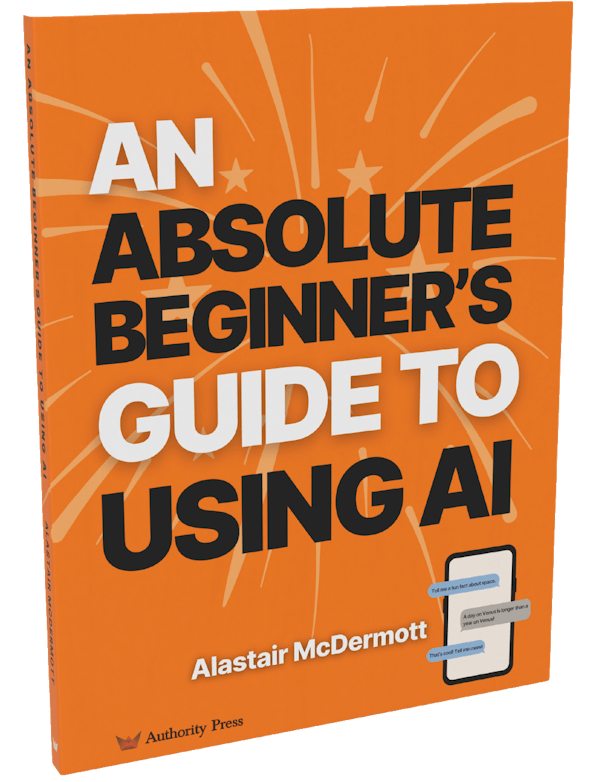When AI Gives You Too Many Ideas (And What To Do About It)
Here’s a challenge that tends to get worse as you get better at working with AI. At first, you’re getting great results, solving problems faster, finding new approaches. Then suddenly you’re drowning in possibilities. I’ve been noticing this pattern for quite a while now, but it wasn’t until a Zoom call today with my friend Al (that’s AL, not A.I.) that I realised just how common this experience is, especially once you’ve moved beyond the basics.
We were using A.I. to solve a business challenge for Al, and it was fantastic. We made what would’ve been a pre-A.I. week’s worth of progress in about 30 minutes. But then we hit a wall. Not because we ran out of ideas. The opposite, actually. And when Al mentioned his own struggles with this same problem, it clicked: this is something that affects all of us, but becomes particularly acute once you’re regularly using AI in your work.
Here’s what keeps happening to me: I open up an AI tool with a clear goal in mind. Within minutes, my screen is absolutely filled with great ideas and suggestions. And at the start it’s incredibly empowering, but as I continue I start to feel overwhelmed, watching my original focus disappear behind a fog of “what about this?” and “have you considered that?”
Sound familiar? You start with a specific project, and before you know it, you’re lost in an endless stream of possibilities. Sure, you’re making progress in the AI chat, but translating that into real-world action? That’s where things fall apart.
It’s like having an overenthusiastic brainstorming partner who never runs out of energy – or ideas. Great in theory, overwhelming in practice.
Getting Unstuck: What’s Actually Working For Me
1️⃣ Start With a Reality Check
Before diving into AI brainstorming, I write down my actual constraints – budget, time, team size, whatever matters. It’s basic, but it helps me filter ideas faster. Every suggestion has to pass through this reality filter first.
2️⃣ Break It Down (Before It Breaks You)
When an idea seems promising, I immediately make it smaller. Instead of letting AI spin up grand plans, I ask for specific, doable next steps. What could we actually start on this week? What’s the smallest version we could test?
3️⃣ Use a Simple Scoring System
I learned this one the hard way: rate ideas immediately or they’ll all start looking equally good. I use a really basic 1-5 score on:
- ➡️ How hard would this actually be to do?
- ➡️ What impact could it really have?
- ➡️ Can we start on this now, or does it need ten other things first?
4️⃣ Test One Thing (Just One!)
This is probably the most important change I’ve made: pick one idea and run a small test. Not a perfect test, not a complete rollout – just a quick pilot to see what happens in the real world. It’s amazing how fast this cuts through the theoretical debates.
5️⃣ Set Some Guardrails
I used to let AI sessions run wild. Now I set strict limits:
- ✅ 10 minutes max for initial brainstorming
- ✅ No more than 3 main ideas to consider
- ✅ One specific problem at a time
6️⃣ Check In With Reality Often
Every week, I look at what actually worked versus what just sounded good. It’s helped me get better at spotting which AI suggestions are practical and which ones are probably going to stay theoretical.
A Meta Solution (Because Why Not?)
Here’s something Al and I realised during our call – we can actually use AI to help manage this AI idea overflow. I know, it sounds a bit like fighting fire with fire, but hear me out:
The thing is, AI is an incredible tool – maybe too incredible sometimes. The challenge isn’t getting good ideas anymore. It’s figuring out which ones to actually run with, and how to turn them into real progress.
I’m still working on getting better at this (and if you’ve found other approaches that work, I’d love to hear them), but these strategies are helping me turn that overwhelming flood of ideas into actual, meaningful progress.
What Next?
Pick one of these approaches – just one! – and try it this week. I’d start with either the reality check or the scoring system. They’re quick to implement and make everything else easier.
Let me know what works for you. I’m still figuring this out too, and I’d love to hear your experiences.









